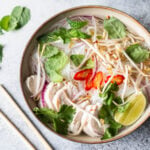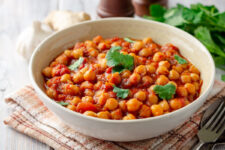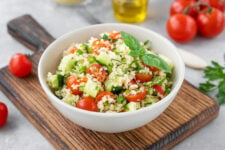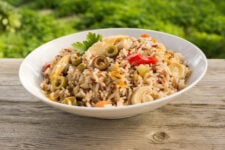Warm, comforting, and flavorful, Pho is a Vietnamese soup that has exploded in popularity in recent years.
Pho is made by cooking rice noodles, various proteins, and vegetables in a simmering broth full of herbs and spices. Then it’s topped with fresh garnishes such as herbs, bean sprouts, and lime wedges.
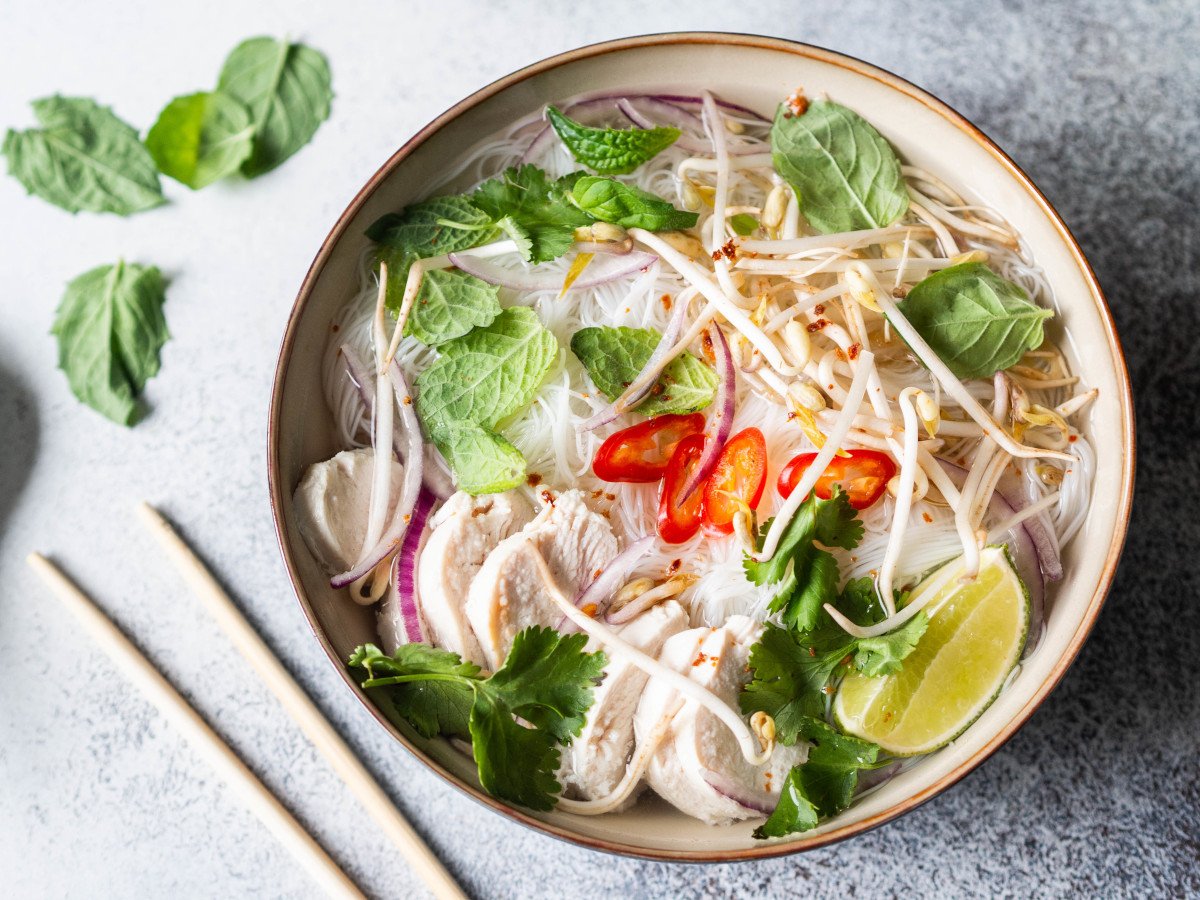
Pho is popular for its rich, flavorful profile and is seen as a comforting and healing soup. You may enjoy eating a delicious bowl of pho at your favorite Vietnamese restaurant, but how healthy is pho?
Is Pho Healthy?
Pho contains many healthy ingredients, like protein, vegetables, bone broth, herbs, and spices, but it can be very high in sodium and calories depending on how it’s prepared. In the restaurant setting, pho is often served in a large bowl, making it easier to consume a bigger-than-average portion of the soup.
Nutrient-dense vegetables and herbs like ginger, basil, carrots, bok choy, and mushrooms provide vitamins, minerals, and antioxidants. The bone broth base of pho also packs a nutritious punch.
The calories in pho can vary greatly but primarily come from the noodles and the meat. The sodium is the highest in the broth base, with one bowl of pho containing 980 mg of sodium (41% of the daily recommended sodium intake) (1, 2).
How to make pho healthier
If you love pho but are concerned about the sodium and calories, there are a few simple tips you can follow to make sure the pho you are ordering is healthy.
First, choose a lean protein, like chicken, turkey, egg, or tofu. These protein options contain less fat and calories than beef and pork.
Next, increase the fiber and nutrient content of the soup by including more vegetables and choosing brown rice noodles if possible. You can also ask for fewer noodles if you are watching your blood sugars or are concerned about your weight.
Lastly, be mindful of your portion. A healthy pho order can still become high calorie if the portion is very large. Listen to your body’s fullness signals to eat the right amount for you.
The healthiest way to eat pho is to make it at home. This way, you can not only control the ingredients and the portions, but you can also adjust the sodium content by adding less salt to your broth or by purchasing a low-sodium broth for the base of the soup.
Health Benefits of Pho
You may be wondering about the specific health benefits of pho soup. Pho is an excellent source of protein, and the unique combination of herbs, spices, vegetables, and bone broth adds vitamins, minerals, and anti-inflammatory benefits.
Protein source
Pho is traditionally served topped with a protein, which is often added raw and cooked by sitting in the piping hot broth. Bone broth also contains protein in the form of gelatin (3).
However, not all proteins are created equal. Red meat, like beef and pork, contains higher amounts of saturated fat and is associated with an increased risk of cancer, heart disease, and type 2 diabetes.
The US dietary guidelines recommend limiting your intake of red meat and focusing on poultry, fish, eggs, and plant proteins instead. Tofu is a common protein option for pho and is known to reduce the risk of heart disease (4).
Bone Broth
Bone broth is the base of pho, though it’s not present in the vegetarian and vegan versions. It’s made by slowly simmering bones and connective tissue from various types of meat.
Bone broth contains nutrients like glucosamine, chondroitin, and collagen, which may help support joint and skin health (5, 6). It also has numerous minerals, such as iron, potassium, and magnesium, though they are in small amounts (3).
Herbs and spices
Pho is packed with herbs and spices, both in the broth and the toppings. Common ingredients include ginger, green onions, star anise, cloves, cinnamon, green chiles, and cilantro.
Ginger is often eaten for its anti-inflammatory properties. It may also reduce cancer risk, improve blood sugar levels, and help digestion (7, 8).
Star anise is known to have antiviral properties as well as being a source of antioxidants and phytochemicals (9).
Early studies show cilantro may help lower blood sugar levels and provide a source of anti-inflammatory antioxidants (10, 11).
Health Risks of Pho
You may be interested in reaping the health benefits of pho but are unsure if pho is healthy for certain groups, such as people who have diabetes or are pregnant.
Is pho safe for pregnancy?
The main concern about consuming pho while pregnant is food safety. The meat or egg is commonly cooked by the heat of the broth at the time of serving, which makes it easier to be undercooked.
Pregnant women should avoid rare and undercooked meats and eggs due to the risk of foodborne illness. Similarly, raw bean sprouts, another common pho topping, can also carry this risk (12).
To reduce the possibility of foodborne illness, consider ordering tofu instead of meat. You can also ask for the meat to be fully cooked before it’s added to the pho. Lastly, skip the bean sprouts since they generally won’t be cooked enough when used as a topping.
Is pho good for diabetes?
Pho can be an excellent option for people with diabetes, especially when it contains lean proteins and a variety of vegetables. However, the carbohydrate of pho can be quite high due to the rice noodles.
Consider asking for a smaller portion of noodles to reduce the carbohydrate count. If brown rice noodles are an option, these can be a great way to increase fiber and reduce the glycemic load of the noodles.
If preparing pho at home, some people like to use lower-carb noodle alternatives, such as hearts of palm noodles, which significantly reduce the carbohydrate amount.
Is pho gluten-free?
Pho is often thought of as gluten-free since it’s made with rice noodles, a gluten-free carbohydrate. However, when eating pho at a restaurant, it’s important to be aware of other ingredients and the preparation method.
Many sauces used in making pho, such as soy sauce, fish sauce, and hoisin sauce, often contain gluten. Broths sometimes contain flour as a thickening agent, making them no longer gluten-free.
In addition, most restaurants do not have a gluten-free kitchen space, which makes cross-contamination a concern, especially for people with celiac disease.
The best way to avoid gluten is to choose a gluten-free restaurant or to prepare your pho at home.
Is pho healthy when you’re sick?
It is common to have a low appetite and an upset stomach when sick, making it challenging to get enough nutrition. Pho is a healthy option to give you the balanced nutrition you need while recovering.
Not only is it warm and comforting, but it’s easy to digest and contains a wide array of nutrients. Pho also contains immune-boosting ingredients like ginger.
Next time you’re sick, try ordering a steaming bowl of pho to go.
Healthier Chicken Pho
Ingredients
Charred Aromatics
- 1 tbsp olive oil or avocado oil, if you have it
- 2 onions halved
- 1 thumb ginger about a 2" piece, sliced in half
Pho Soup Broth
- 6 cups chicken stock low sodium
- 1 cup water
- 1 lb chicken breast
- 1 bunch cilantro
- 5 star anise pods
- 1 cinnamon stick
- 4 cloves
- 2 tsp fennel seeds
- 2 tsp coriander seeds
- 3 tsp coconut aminos substituted for fish sauce, we like this brand
- 4 tsp sugar slightly reduced from the original recipe
- 1/2 tsp kosher salt slightly reduced from the original recipe
Noodle Bowls
- 13 oz brown rice noodles dry, thin, flat (we like this brand)
- 2 green onion
Toppings
- 2 cups bean sprouts
- 1 small bunch thai basil
- 1 small bunch mint
- 1 small bunch cilantro
- 2 limes
- red chilis finely sliced
- Hoisin sauce optional, to taste
- Sriracha optional, to taste
Instructions
Broth
- In a 6 quart pot, heat the olive oil over high heat. Place ginger and onion sliced sides down and cook for 2 minutes until blackened. Turn over and cook for another 2 minutes.
- Put spices, chicken stock and water in the pot with the chicken breast. Bring to a boil and simmer for 10 minutes, until the breast is cooked. Remove the chicken breast and shred or thinly slice.
- Simmer the remaining liquid for 30 minutes with the lid open a bit to allow some steam to escape. The liquid should be reduced to about 1 1/2 quarts. Strain the broth into a clean pot and keep warm until ready to serve.
Assembly
- Place toppings out on the table.
- Reheat the chicken by giving it a brief dunk in the broth.
- Prepare brown rice noodles per package directions, just prior to serving. Drain very well so that the excess water doesn't dilute the broth.
- Place brown rice noodles in bowls. Top with chicken, ladle over about 1/5 cups of the broth. Top with green onions.
- Add toppings of choice, squeeze some lime juice into the broth, and enjoy immediately.

